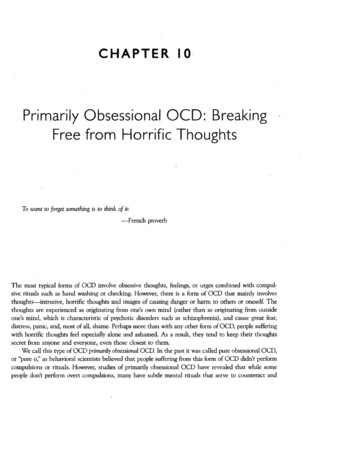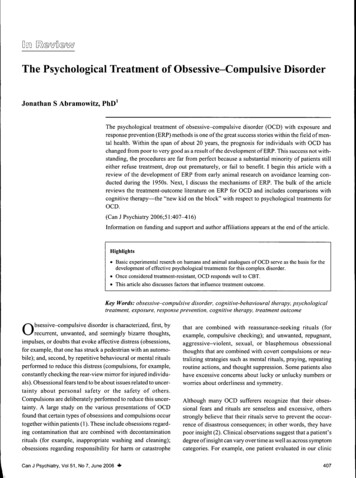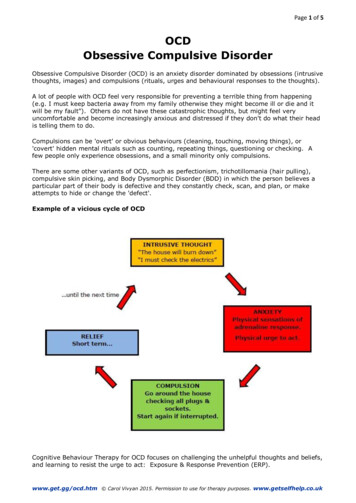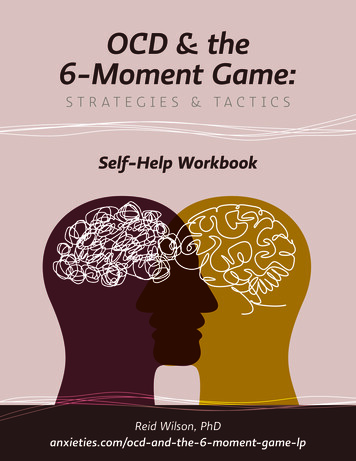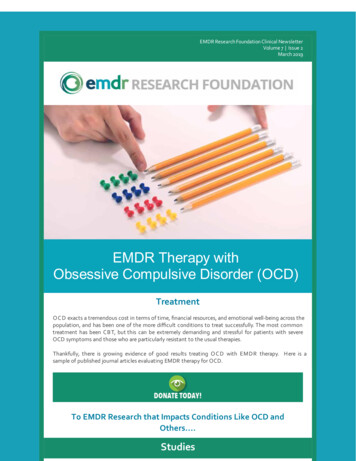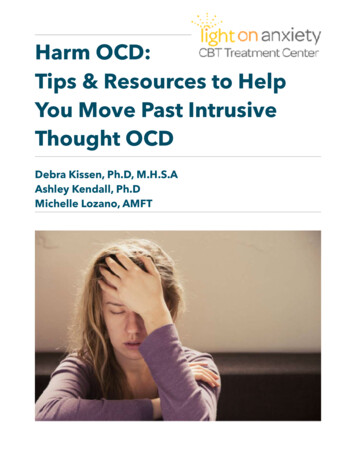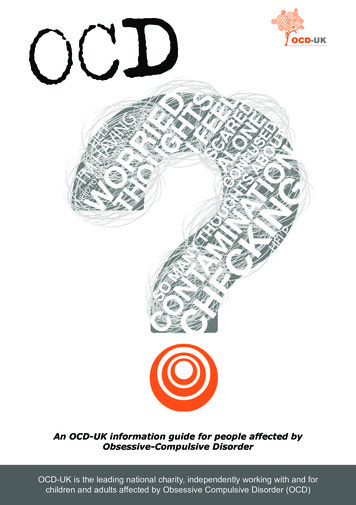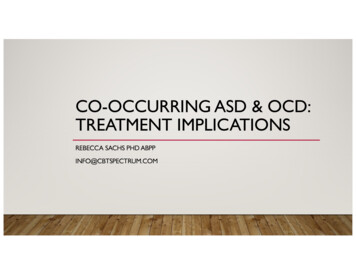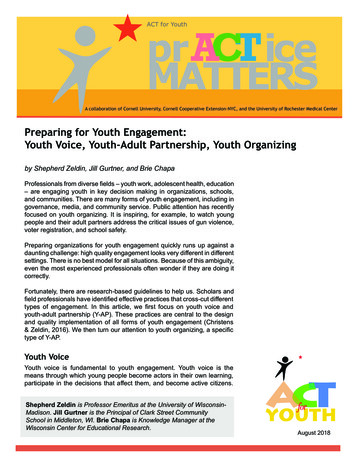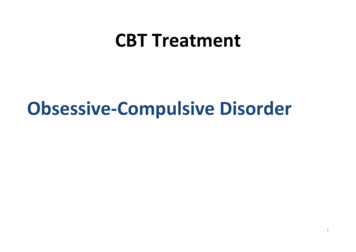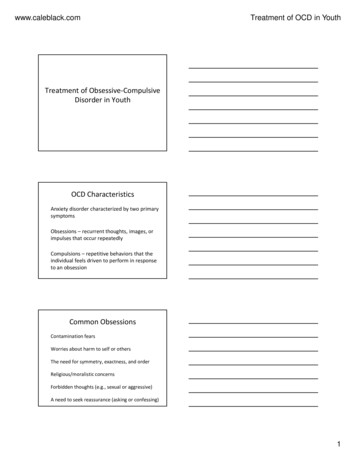
Transcription
www.caleblack.comTreatment of OCD in YouthTreatment of Obsessive-CompulsiveDisorder in YouthOCD Characteristics Anxiety disorder characterized by two primarysymptoms Obsessions – recurrent thoughts, images, orimpulses that occur repeatedly Compulsions – repetitive behaviors that theindividual feels driven to perform in responseto an obsessionCommon Obsessions Contamination fears Worries about harm to self or others The need for symmetry, exactness, and order Religious/moralistic concerns Forbidden thoughts (e.g., sexual or aggressive) A need to seek reassurance (asking or confessing)1
www.caleblack.comTreatment of OCD in YouthCommon Compulsions Decontamination rituals Confessing Checking Praying Counting Seeking reassurance Repeating Touching, tapping orrubbing Straightening Avoidance Ritualized behaviorsOCD Symptom Dimensions Contamination symptoms Obsessions and checking Symmetry and ordering Hoarding Also numerous miscellaneous symptomsOCD in Youth Prevalence of 1-2.3% under 18, 0.5-1.0% point– More common in boys About 75% present with comorbid Axis I Also show numerous other impairments– Overall QoL, sleep, problematic peer relations,academic difficulties, fewer recreational activities2
www.caleblack.comTreatment of OCD in YouthOCD in Youth Compared to adults, youth often show– Greater number of symptoms– Higher level of impairment Also show high levels of family accommodationand “just right” symptomsTreatment Options Medication alone - the most well supportedare serotonin reuptake inhibitors Paroxetine (Paxil), fluoxetine (Prozac),fluvoxamine (Luvox), sertraline (Zoloft),clomipramine (Anafranil) Small-medium overall effect sizes, though(0.42, or 60% improve)Treatment Options Psychosocial treatment - most well supportedis cognitive-behavioral therapy with a focuson exposure with response prevention (ERP) Effect sizes of 1.16-1.72 (88-95% improve) Play therapy, psychodynamic, and supportivetherapies not found to be effective3
www.caleblack.comTreatment of OCD in YouthTreatment Options Combined medication and CBT been found tobe highly effective as well Overall, treatment guidelines are to eitherstart treatment in youth with OCD on– CBT alone (lower symptoms and impairment)– Combination of CBT and medication (very highlevel of symptoms and impairment)Exposure with Response Prevention The treatment of choice for both adults andyouth with OCD Patient is exposed to feared situation, thenprevented from engaging in their “normal”(OCD) response until anxiety decreasesOutline of CBT Treatment Typically between 10-16 sessions Include parents and child in all aspects oftreatment, may need to include other family Three primary components– Psychoeducation, parent education, cognitivestrategies and ERP4
Correctmisattributions Differentialattention Modeling ScaffoldingChild Tools Provide OCDneurobioinformationTreatment of OCD in YouthParent ToolsPsychoeducationwww.caleblack.com Learn how toexternalize OCD Learn how touse rate anxiety Differentiatebetween OCDand non-OCD DescribetreatmentprogramConsiderations Keep information and activities developmentallyappropriate– For young children (under 8), they may notneed/benefit from the education portion– Older children and adolescents, however, should beincluded Deliver treatment “with the child” and not “tothe child”Session Sequence An initial assessment should be conductedprior to therapy starting Complete a clinical interview (KSADS, ADIS-C)and symptom measures (CY-BOCS, FAIS-C) Helps determine differential or comorbiddiagnoses and impact of OCD symptoms onfunctioning5
www.caleblack.comTreatment of OCD in YouthSession 1 Results of assessment Provide education on– Etiology and course of OCD– Cormorbidity– OCD vs non-OCD behaviors Give overview of treatment program Homework – daily record of OCD symptomsSession 2 Review past session Start development of hierarchy Give overview of parent and child tools Introduce differential attention and rewardplan Homework – Track two OC symptoms,prepare rewards and reward chart6
www.caleblack.comTreatment of OCD in YouthExercise! You will now create your own fear hierarchies Should include a wide range of fears and/orsituations that are distressing Use SUDs ratings to distinguish and order thehierarchyQuestions?7
www.caleblack.comTreatment of OCD in YouthSession 3 Review last week Introduce child to reward program Review OCD symptoms with child Introduce feeling thermometer/symptomtracking (child tools)Session 3 Discuss praise & encouragement Review level of family involvement in andaccommodation of OCD symptoms Homework – Monitor symptoms, start rewardchart for doing so New hierarchy (therapist between sessions)8
www.caleblack.comTreatment of OCD in YouthSession 4 Review last week Problem solve homework or reward program Continue hierarchy development Introduce arguing with OCD Conduct in-session exposureExposures Imaginal exposure tasks– Often used in the beginning, or when the child hasabstract worries / fears– Allows for practicing coping skills beforeconfronting the real situation In vivo exposure tasks– Often follow imaginal exposures, use a “live and inperson” version of the feared situation9
www.caleblack.comTreatment of OCD in YouthExposures Exposure occur both in and out of session Requires cooperation of parents to facilitatesuccessful homework exposures Should be similar to what is being done insession, using a hierarchy and SUDs ratings Internal and external rewards for successfulexposure completion should be discussedbeforehandExposures Ideal exposures are prolonged, repeated, andprevent the use of distraction behaviors SUDs decrease of at least 50%, with morebeing better May require shaping up to the more difficultsituations, in terms of both time and use ofdistractorsTherapist Tasks Realize long-term benefits outweigh shortterm distress, and communicate this effectiveto the family Work collaboratively with the child and familyto plan and execute the exposures Maintain rapport during exposures by buildingupon pre-established rapport10
www.caleblack.comTreatment of OCD in YouthTherapist Tasks Do not allow avoidance or distracterbehaviors during the exposure Modeling how to conduct exposures for theparents, so that they can perform them athome Be flexible and creative when dealing with lessthan optimal exposures and resistanceObstacles for the Therapist I’m making my client more upset / anxious It’s difficult to see people in distress Can be emotionally draining for sometherapists May have to do exposures that you are notcomfortable withExercise! In vivo exposure demonstration Please welcome my office mate Monty!11
www.caleblack.comTreatment of OCD in YouthSession 4 Discuss diff. att. – especially ignoring Review family involvement in OCD symptoms Problem solve homework complianceobstacles Homework – ERP task completion, parents usepositive attention and ignoringSession 5 Review last week Problem solve homework tasks Revise hierarchy of symptoms Review arguing with OCD Conduct in-session exposure12
www.caleblack.comTreatment of OCD in YouthSession 5 Discuss modeling Homework– Parental modeling, use of differential attention– Child complete ERP task(s) each daySession 6 Review last week Problem solve homework tasks Review disengagement efforts Revise hierarchy of symptoms & arguing Introduce scaffolding/coachingScaffolding Step 1 – Find out how child feels and empathizewith the child Step 2 – Brainstorm with child how to approachthe situation Step 3 – Choose option from Step 2 and act on it Step 4 – Evaluate and reward13
www.caleblack.comTreatment of OCD in YouthSession 6 Conduct in-session exposure Review scaffolding/coaching steps Homework– Parents use modeling, DA, scaffolding, continuedisengagement, reward task completion– Child completes ERP task(s) each daySession 7 Review past week Problem solve homework Review disengagement Revise hierarchy of symptoms & arguing Conduct in-session exposure to check parentalscaffoldingSession 7 Expand use of scaffolding outside of ERPpractice tasks Homework– Encourage use of all parental tools– Have parents apply scaffolding outside plannedpractice times– Child complete ERP task(s) each day14
www.caleblack.comTreatment of OCD in YouthSessions 8-10 Review past week Problem solve homework Review disengagement Revise hierarchy of symptoms & arguing Conduct in-session exposures Homework assignmentsFurther sessions Take place two weeks after previous sessions Similar to 8-10 Focus on how to handle OCD future problems– Relapse prevention strategies– Dealing with symptom reappearanceEnding Therapy Sessions should be spaced further apart Some families may need more boostersessions than others Plan on having long-term follow-up visits tocheck progress and troubleshoot15
Hierarchy of Feared SituationsWrite down all the situations which distress you, then add them to the table below, in order ofhow distressing they are. In the last column, rate how distressed each one makes you, from 0(no distress) to 10 (maximum lyavoid?yes / noDistress0 – 10www.get.gg
www.caleblack.comTreatment of OCD in YouthRecommended resourcesFor the therapist: Jennifer Freeman & Abbe Marrs Garcia’s Family-Based Treatment for Young Childrenwith OCD (Therapist Guide) – ISBN 978-0-19-537363-9 John Piacentini, Audra Langley, & Tami Roblek’s Cognitive Behavioral Treatment ofChildhood OCD: It's Only a False Alarm (Therapist Guide) - ISBN 978-0-19-531051-1 Eric Storch, Gary Geffken, & Tanya Murphy’s Handbook of Child and AdolescentObsessive-Compulsive Disorder – ISBN 978-0-80-585766-5 John March & Karen Friesen’s OCD in Children and Adolescents: A Cognitive-BehavioralTreatment Manual – ISBN 978-1-57-230242-6For the family: Jennifer Freeman & Abbe Marrs Garcia’s Family-Based Treatment for Young Childrenwith OCD Workbook – ISBN 978-0-19-537364-6 John Piacentini, Audra Langley, & Tami Roblek’s It's Only a False Alarm: A CognitiveBehavioral Treatment Program Workbook – ISBN 978-0-19-531052-8 John March’s Talking Back to OCD – ISBN 978-1-59-385355-6 Dawn Huebner’s What to Do When Your Brain Gets Stuck: A Kid's Guide to OvercomingOCD - ISBN 978-1-59-147805-8 Holly Niner’s Mr. Worry: A Story about OCD – ISBN 978-0-80-755182-0
Treatment of Obsessive-Compulsive Disorder in Youth OCD Characteristics Anxiety disorder characterized by two primary symptoms Obsessions -recurrent thoughts, images, or . Behavioral Treatment Program Workbook - ISBN 978--19-531052-8 John March's Talking Back to OCD - ISBN 978-1-59-385355-6 .

